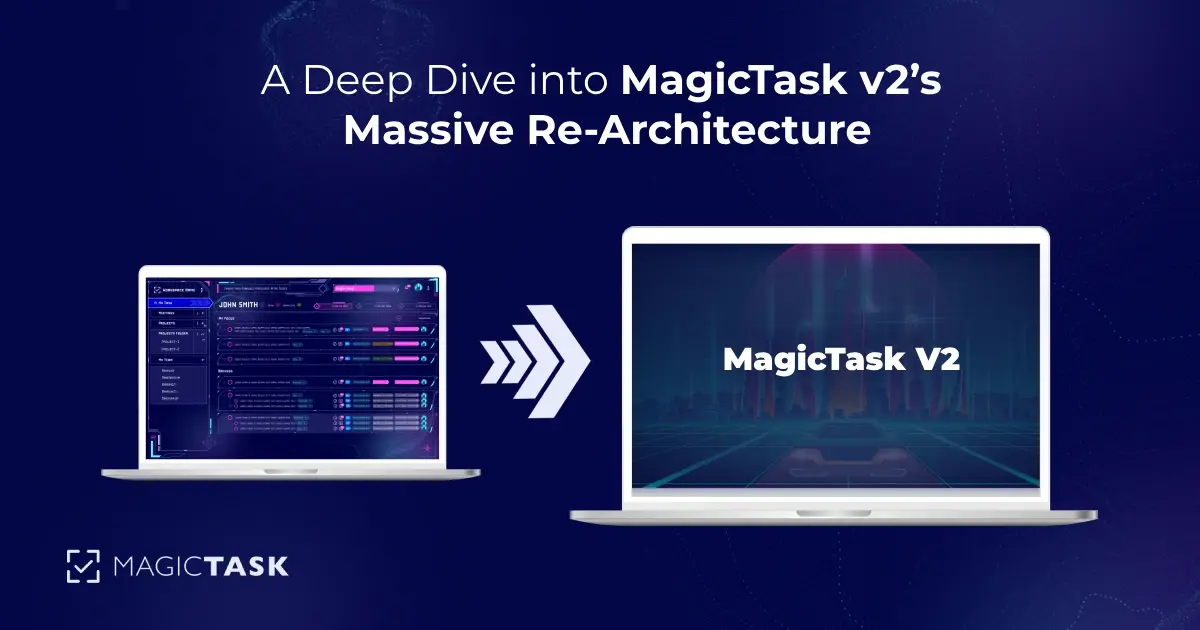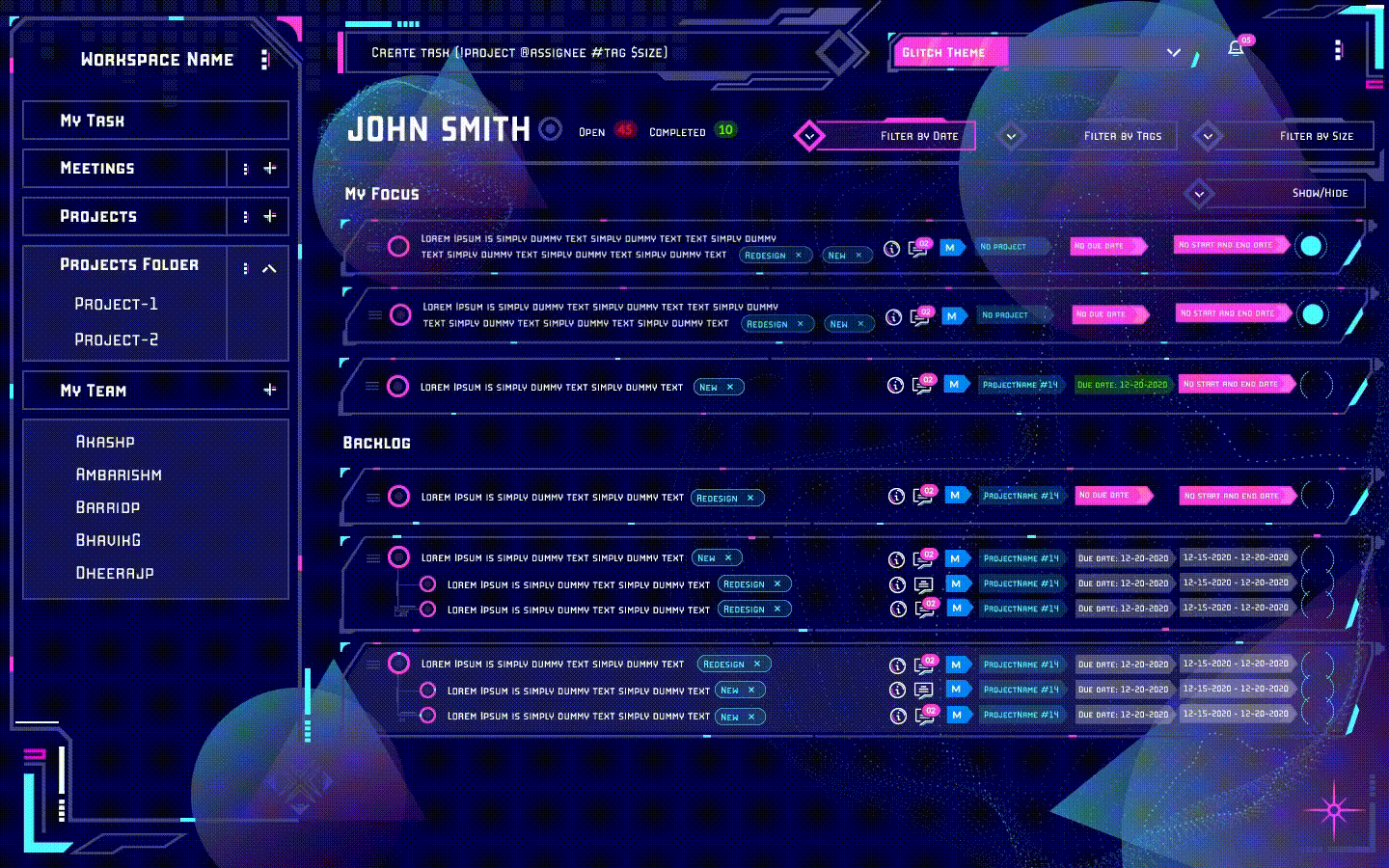A Deep Dive into MagicTask v2’s Massive Re-Architecture

Greetings MagicTaskers and devotees of efficient productivity!
We hope this message finds you well and thriving in your pursuits. Today marks a significant milestone for our entire community and for the productivity landscape at large. We are absolutely thrilled to present to you a colossal update to our much-beloved MagicTask V2 system. This isn't just any update; it's the culmination of countless hours, endless brainstorming sessions, and relentless dedication that our team has invested in since the early days of February 2023.
The whispers of MagicTask V3 are indeed growing louder, hinting at a promising future filled with even more advanced features and innovative solutions. However, our commitment to ensuring that our existing platform remains impeccable has never wavered. We firmly believe that the backbone of our suite of tools, MagicTask V2, deserved a comprehensive revitalization. It is our way of demonstrating our unwavering commitment to you, our esteemed users, who constantly push the boundaries of what's possible and challenge us to elevate our standards.
As we stand at this juncture, eager and proud to showcase the result of months of intricate work, we invite you to journey with us into the intricate layers of technology. Let's dive headfirst, together, into the nuanced world of our system’s architecture, the major transformations it has undergone, and the game-changing performance boosts now at your fingertips. Dive in, explore, and experience firsthand the next evolution of productivity with MagicTask V2.
Code Level Namings: Journey from Ambiguity to Precision with Project & Tag Refinement
In the intricate world of coding, just as in the complex tapestry of life, precision and clarity aren’t just desired, they are indispensable. As MagicTask evolved, transitioning from its nascent V0 to its burgeoning V1 and finally to the current V2, we realized the necessity of introspection. Over time, amidst the whirlwind of updates and innovations, our codebase had unfortunately begun to resemble a tangled web of misnomers and overlapping terminologies. This wasn’t merely a cosmetic oversight; it was a burgeoning impediment that threatened to hamper our development velocity.
One of the most pronounced areas of confusion was our code-level namings. As developers sifted through lines of code, the interchangeable usage of 'tag' and 'label' caused more than a few furrowed brows. Our backend nomenclature, instead of being an aid, was often at odds with our front-end language, leading to avoidable back-and-forths and interpretative challenges.
Recognizing this, we've made deliberate strides in our latest update. 'Tag' has now been seamlessly transitioned to 'project', and 'label' has found its true identity as 'tag'. While it might seem like a minor tweak on the surface, this streamlining is a monumental leap toward eliminating ambiguity. It not only resonates with the user experience but ensures our developers have a clear, unambiguous lexicon to work with. This paves the way for more agile and efficient developmental cycles in the future, ensuring that MagicTask remains as user-centric and innovative as ever.
Optimized Responses and Minified Magic: The Technical Unveiling
In the modern age of digital information, the speed at which data is processed and relayed back to the user is paramount. As we dive into the vast universe of web development and performance optimization, one truth stands clear: every millisecond matters, and each byte holds value. To provide the most responsive user experience, we need to ensure our system operates at the pinnacle of efficiency. With the latest update to MagicTask V2, we're proud to introduce our revamped response system, shedding any excess weight and enhancing speed – let’s journey into the technical intricacies behind these improvements.
The Science of Minification
Minification, for those unfamiliar with the term, is a process wherein all unnecessary characters (like white spaces, line breaks, and comments) from source code are removed without altering its functionality. Consider it akin to a highly efficient packing system; by removing all excess air and unused space from a package, you're left with a compact, streamlined parcel that can be delivered more quickly.
For instance, consider this simple JavaScript function:
function addNumbers(a, b) {
* ** return a + b;***
}
When minified, it transforms into:
function addNumbers(a,b){return a+b;}
This reduction may seem trivial, but when scaled to thousands of lines of code, the saved space accumulates, leading to faster loading times and a more efficient system overall.
Optimized Responses: Beyond Just Minification
While minification plays a critical role, our quest for optimization didn't stop there. The responses from our server have been meticulously crafted to eliminate any redundant data. For example, in the past, a user query about a task might have returned extensive metadata about the task, including creation timestamps, previous edits, associated tags, and more. However, if a user merely wanted to know the task's title and deadline, sending all that additional data was overkill.
By optimizing our responses, we've shifted to a more context-aware system. If a user requests specific data, our system now ensures only that particular data, in its most concise form, is sent. This precision reduces the load on our servers, minimizes data transfer times, and ensures quicker rendering on the user's end.
A Real-World Impact
Imagine you're accessing MagicTask on a slow mobile connection while commuting. Every kilobyte of unnecessary data can mean the difference between a task loading in a split second versus a frustrating several-second delay. By minifying our codebase and optimizing our response structure, we've effectively minimized that wait time, granting users quicker access to their tasks and a smoother experience, irrespective of their internet connection's strength.
The enhancements to MagicTask V2 are not merely surface-level improvements. They are a manifestation of our commitment to ensuring that every user interaction is seamless, efficient, and swift. Through minification and response optimization, we're ensuring that our platform remains at the forefront of productivity tools, delivering magic in every click, swipe, and keystroke.
Fine-Tuned Database Interactions: The Pursuit of Peak Performance

The digital realm we traverse today demands precision and speed. Like a symphony where each note holds significance, every database call in a system must have purpose and efficiency. With the revamped MagicTask V2, we've delved deep into our database's inner workings, aiming to provide a flawless performance worthy of our users' expectations.
The Ghost of Redundancy
Database calls, when excessive or unnecessary, can act as invisible drags on performance, sometimes making applications feel sluggish and unresponsive. These redundant interactions were our first target. By revising our backend algorithms and implementing stringent checks, we've eliminated any superfluous database calls. This means that every interaction with our database now serves a direct, meaningful purpose, ensuring that system resources aren't wasted on tasks that don't contribute to the end user's experience.
Harnessing the Power of Mongo Indexing
MongoDB, a pillar of our system's architecture, offers powerful tools to enhance database operations. One such tool is indexing. Imagine trying to find a particular book in a vast library without a catalog – daunting, right? Indexing acts as that catalog, providing a structured path to the data. By embracing Mongo indexing, we've made it exponentially quicker to locate and retrieve specific data sets. No longer does the system have to scan every record; instead, it can jump directly to the desired data point, slashing query times dramatically.
Advanced Database Tuning: The Final Touch
But our quest didn't stop with eliminating redundancy and implementing indexing. Advanced database tuning allowed us to further refine our interactions with the database. This involves adjusting various parameters, allocating resources efficiently, and streamlining data structures to accommodate better the kind of queries MagicTask V2 primarily handles. As a result, not only have individual queries sped up, but the overall health and responsiveness of the database have also been enhanced.
This comprehensive overhaul of our database interactions reflects our undying commitment to deliver unmatched speed and reliability. With these changes in place, MagicTask V2 users can expect a more fluid, responsive, and efficient experience, ensuring that they spend less time waiting and more time achieving.
Task and Template Terminology Alignment: Bridging the User and the System
In the realm of software and applications, the distance between the user and the system should be almost imperceptible. The closer the user feels to the product, the more intuitive and satisfying their journey becomes. Recognizing this, we embarked on an initiative to bring our backend terminology in line with what our users see and understand every day.
The Dichotomy of 'Todo' vs. 'Focus'
Historically, the terms 'todo' and 'backlog' dominated our backend framework. While these terminologies have been conventionally used in many productivity tools, we realized that our user interface spoke a slightly different language. The term 'focus' emerged in the front-end as a more apt descriptor for tasks that demand immediate attention. 'Focus' not only underscores the urgency of the task but also drives user commitment by emphasizing priority.
To eliminate this discrepancy, we transitioned from 'todo' to 'focus' in our backend nomenclature, ensuring that both the user's view and the system's logic are singing from the same hymn sheet.
The Imperative of Seamless Integration
This alignment was more than just a cosmetic change. By ensuring that backend terms matched those of the front-end, we've simplified cross-team communication, reduced potential errors, and made future developments more streamlined. Developers no longer need to mentally map one set of terms to another, allowing for faster troubleshooting and implementation of updates.
The Result: Enhanced Clarity and Cohesion
This terminology realignment stands as a testament to our commitment to a user-centric approach. By ensuring that both the visible and the invisible layers of our platform speak the same language, we’ve enhanced the overall clarity and cohesion of the MagicTask system. Now, users and developers alike can navigate the platform with a shared understanding, making the MagicTask experience more unified and intuitive than ever before.

Websocket and HTTP 2 Optimizations: Pioneering a Faster MagicTask Experience
Websockets play a pivotal role in achieving the dream of instantaneous communication between the server and the client. They lay the foundation for the real-time interactivity that our users have come to expect from MagicTask. However, like any technology, it requires regular tuning to keep it performing at its best. Recognizing this, we embarked on a mission to refine and streamline our websocket events.
By reducing the bloat and trimming unnecessary data from these events, we've achieved a leaner, faster, and more efficient communication pipeline. This means that every interaction, every update, and every notification you receive via MagicTask is now lightning-quick, providing an almost telepathic feel to our platform's responsiveness.
Embracing HTTP 2 for Enhanced Performance
But we didn't stop there. While websockets handle real-time events, HTTP plays a crucial role in general web communication. With the introduction of HTTP 2, the web witnessed a significant leap in terms of speed, security, and efficiency. We've eagerly adopted HTTP 2 support as a standard for all our API calls. This not only ensures faster data transfer rates but also optimizes the multiple simultaneous connections, resulting in an overall smoother web experience.
The MagicTask Evolution Continues
These enhancements to our websockets and HTTP protocols exemplify our dedication to continuous improvement. We understand that in the world of digital tools, every microsecond can impact user experience. That's why we're committed to constantly refining and optimizing MagicTask to offer our community the quickest, most seamless productivity platform on the market.
Front-end Finesse: A Commitment to Superiority

Tech Stack Transition: A Bold Leap Forward
As the world of digital technology constantly evolves, so must the tools we use to interact with it. At MagicTask, our main goal has always been to provide you with an unparalleled user experience, and our recent front-end updates underline this commitment.
React to Preact+Vite: The Speedy Shift
React, since its inception, has been a reliable partner in our development journey, aiding in delivering a dynamic user interface. However, as our user base grew and demands intensified, we felt the need to transition to a leaner, faster framework. Enter Preact, coupled with Vite. This combination, while retaining the React-like structure, offers a much lighter footprint and faster load times. Vite further boosts our application with its impressive optimization capabilities, resulting in quicker startups and more fluid interactions.
JavaScript to TypeScript: A Secure, Structured Step
While JavaScript has served us well, its dynamic nature sometimes led to unforeseen errors that could be hard to pinpoint. Transitioning to TypeScript, a statically-typed superset of JavaScript, offered us greater security. With TypeScript, our developers can detect errors earlier in the development process, ensuring that what reaches you is stable and bug-free.
Redux to Recoil: Streamlined State Management
State management in large applications can be a beast. While Redux has been a powerhouse in this arena, as our application grew, so did the complexities associated with Redux. Recoil emerged as a perfect solution, offering a more direct and intuitive approach to state management. By adopting Recoil, we've reduced boilerplate code, enhanced maintainability, and ensured that your tasks and data are managed more seamlessly than ever.
A Front-end Promise
In essence, these transitions are not just technical jargon or mere upgrades; they represent our promise to you. A promise that every time you interact with MagicTask, you're experiencing the latest, most optimized, and most user-friendly version of our platform. We've taken the tech-world's best and integrated it into our system, all with one aim: to provide you with a blazingly fast, reliable, and impeccable task management tool.
Superior Notifications: Crafting a Tailor-Made Experience

In the age of information overload, notifications stand as a double-edged sword. While they are crucial in ensuring you never miss a beat, their relevance, timeliness, and efficiency are paramount. At MagicTask, we recognize this delicate balance and took a significant step in perfecting your notification experience.
The Problem with Third-Party Libraries:
Relying on third-party libraries for notifications presented a unique set of challenges. While they offered convenience in the initial phases, we soon realized the limitations they imposed on customization and performance. These libraries, designed to cater to a broad audience, often came with bloatware and unnecessary features irrelevant to our specific needs. Furthermore, their integration sometimes resulted in performance lags, inconsistent user experiences, and a less-than-optimal fit for our evolving platform.
Custom Web Notification System: Our Solution
To combat these issues and provide a truly superior notification experience, we took matters into our own hands. We developed a custom web notification system exclusively for MagicTask. This new system is sleek, efficient, and perfectly integrated with our platform's core functionalities.
Here's what our custom notifications bring to the table:
- Enhanced Performance: Without the overhead of unnecessary third-party code, our notifications are quicker, ensuring instant alerts.
- Personalized Experience: With full control over design and function, we've ensured that every notification you receive is relevant, timely, and devoid of unnecessary distractions.
- Scalability: Our system is designed with the future in mind. As MagicTask grows and evolves, our notification system can seamlessly adapt, ensuring continuous improvements and innovations.
- User Control: Recognizing that every user's preference is unique, we've baked in more customization options. Now, you decide the what, when, and how of your notifications, crafting an experience that's just right for you.
In essence, our shift to a custom web notification system embodies our philosophy at MagicTask: that every feature, no matter how small, should be crafted with the utmost care, keeping you, our valued user, at the heart of every decision. With these revamped notifications, we hope to make your MagicTask journey even more seamless and delightful.
Streamlined Date Updates: Simplifying Task Management
In the realm of task management, where deadlines and schedules reign supreme, the efficiency of date interactions is paramount. While it may seem like a minor tweak on the surface, our newly streamlined date updates are the result of careful deliberation and dedication to making your MagicTask experience as fluid as possible.
The Problem We Identified:
Our previous system, while functional, had an underlying inefficiency: requiring two clicks to modify or remove dates from tasks. It was a small hiccup in an otherwise smooth journey, but we realized that these hiccups, when encountered frequently, could compound into a significant annoyance. Especially for our power users, who juggle myriad tasks daily, those extra clicks added unnecessary seconds, interrupting workflow and productivity.
Our Improved Solution:
Understanding the importance of usability, we revisited our date implementation system. We streamlined the process, eliminating redundancy and ensuring that updates are as intuitive and quick as possible. Now, with fewer clicks, you can effortlessly modify or eradicate task dates.
This might seem like a small step, but in the bigger picture, it’s all about saving those crucial moments, refining the user experience, and reducing any potential friction. By making these changes, we are ensuring that our interface remains user-friendly and that our system understands and evolves according to the rhythms of your daily task management.
In essence, our revamped date update system is more than just a feature enhancement; it's a commitment to continuously optimize every facet of MagicTask for your convenience and productivity.
Code Management Upgrades: Enhancing the Foundations
In any software development lifecycle, one of the pivotal aspects is the code's maintainability and readability. It's the unseen bedrock upon which the towering structures of applications are built. With our recent code management upgrades, we've delved deep into this foundation, ensuring it's as robust and efficient as possible.
The Impetus for Change:
As MagicTask grew, so did the complexity of our codebase. Over time, with various developers contributing and the code evolving, we realized there were inconsistencies. Object and class names, though functional, started to diverge from best practices, causing potential confusion. It wasn't just about a name – it was about the ease with which our developers could understand, navigate, and modify the code.
The Renovation Process:
We undertook a comprehensive review, identifying objects and classes that were ambiguously named or didn't align with their functional intent. By renaming them to be more intuitive and in line with contemporary coding standards, we've created a more cohesive and unified codebase.
The Endgame Benefits:
This might appear as a backstage adjustment, but the ripple effects are profound. With cleaner code, our development team can pinpoint issues faster, implement new features with increased accuracy, and ensure that any necessary updates are rolled out efficiently. For our users, this means a more stable MagicTask environment, quicker updates, rapid bug fixes, and the smooth introduction of innovative features in the near future.
In sum, this meticulous refinement of our code management isn't just a technical tweak; it's a strategic move aimed at ensuring MagicTask's longevity and adaptability in the evolving digital landscape.
Conclusion
MagicTask V2's recent updates are more than just a series of technical changes. They represent our unwavering commitment to provide a platform that isn’t just efficient, but also intuitive and delightful to use. As we gear up for the exciting leap to MagicTask V3, this revamped V2 ensures that our foundation is rock-solid.
We’re genuinely thrilled to roll out these changes, and we encourage feedback and thoughts. Our goal, as always, is to craft a tool that's not just powerful but also a joy to use. With this update, we believe we've taken a giant leap in that direction.
So, to all the MagicTaskers out there: Dive in, experience the upgrades, and let's continue this incredible journey of gamified productivity together. Game on! 🎮🚀




